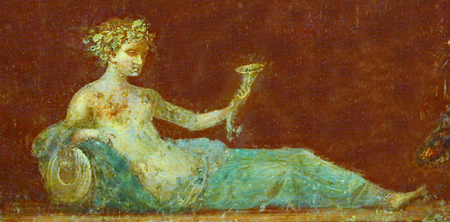 Banqueter reclining with a drinking horn, Stabiae, 30-50 CE
Banqueter reclining with a drinking horn, Stabiae, 30-50 CE
 Banqueter reclining with a drinking horn, Stabiae, 30-50 CE
Banqueter reclining with a drinking horn, Stabiae, 30-50 CE
This most un-Roman of all the Worlds came into being in the last half century of the Republic and outlived it by barely a generation. It was a world of floating artifice, a fiction constructed by the elegiac love poets that ran headlong into Augustus' program to rescue the mores maiorum (customs of the ancestors) and restore traditional Roman dignitas. This world was populated by un-Roman personalities: the young poet lover, his girlfriends — married women and prostitutes both —, absent elderly husbands, indulgent fathers, and conniving slaves. Its concerns were the pursuit and attainment of pleasure, for which love and the beloved were symbols. Women acted autonomously, choosing to marry sine manu, without passing into the legal and financial control of their husbands, which gave them greater personal freedom. The leading spokesmen for this world were male poets — Gallus, Catullus, Propertius, Tibullus, Horace, and Ovid — with the bright exception of Sulpicia. Although women and passion were at the center of this world, they were viewed through the eyes, words, and appetites of the male author. The new woman stepped lightly in her flimsy, transparent garments from one lover to another, enslaving them and leaving them with no regrets and no consequences. At last, setting as examples his own daughter Julia and the brazen Professor of Love Ovid himself, Augustus lowered the curtain on this world through legislation and exile, silencing its public expression if not its wantonness. See Greene (1998), James (2003), Pandey, Wyke (2002) in the Bibliography and Images of Flirtation below.
| Text-Commentaries | Additional Readings |
|---|---|
| Publius Ovidius Naso, Amores III.2: Circus pick-up | See the Latin reader The Worlds of Roman Women for the following texts: |
| Gaius Valerius Catullus, Carmina 70: She says, he says | Sextus Propertius, Elegiae 2.23.12-20: choosing a partner |
| Sextus Propertius, Elegiae III.23: Love tablets | P. Ovidius Naso, Ars Amatoria 1.135-162: hunting in the Circus |
| Cornelius Tacitus, Annales II.85.1-4: Vistilia | P. Ovidius Naso, Ars Amatoria 3 (excerpts): how to get a man |
| Gaius Valerius Catullus, Carmina 27: Postumia | Q. Horatius Flaccus, Carmina 3.9: Lydia and her lover |
| Quintus Horatius Flaccus, Carmina I.23: Chloe | Sulpicia, Elegidia 1-6: she sings of love |
| Quintus Horatius Flaccus,Carmina I.5: Pyrrha | |
| Decimus Magnus Ausonius, Epigrammata 89: Amica | See De Feminis Romanis at Diotima for the following Latin text: |
| Titus Maccius Plautus, Mostellaria I.3: Philematium and Scapha | Sulpicia, Opera omnia 1-6 |
| Gaius Valerius Catullus, Carmina 3: Passer is dead | |
| Quintus Horatius Flaccus, Carmina I.22: Lalage | |
| P. Ovidius Naso, Metamorphoses 7.10, C. Valerius Flaccus Argonautica 7.9: Medea | |
Funerary Inscription: |
|
| for Maria Auxesis |
All images are courtesy of the VRoma Project's Image Archive.